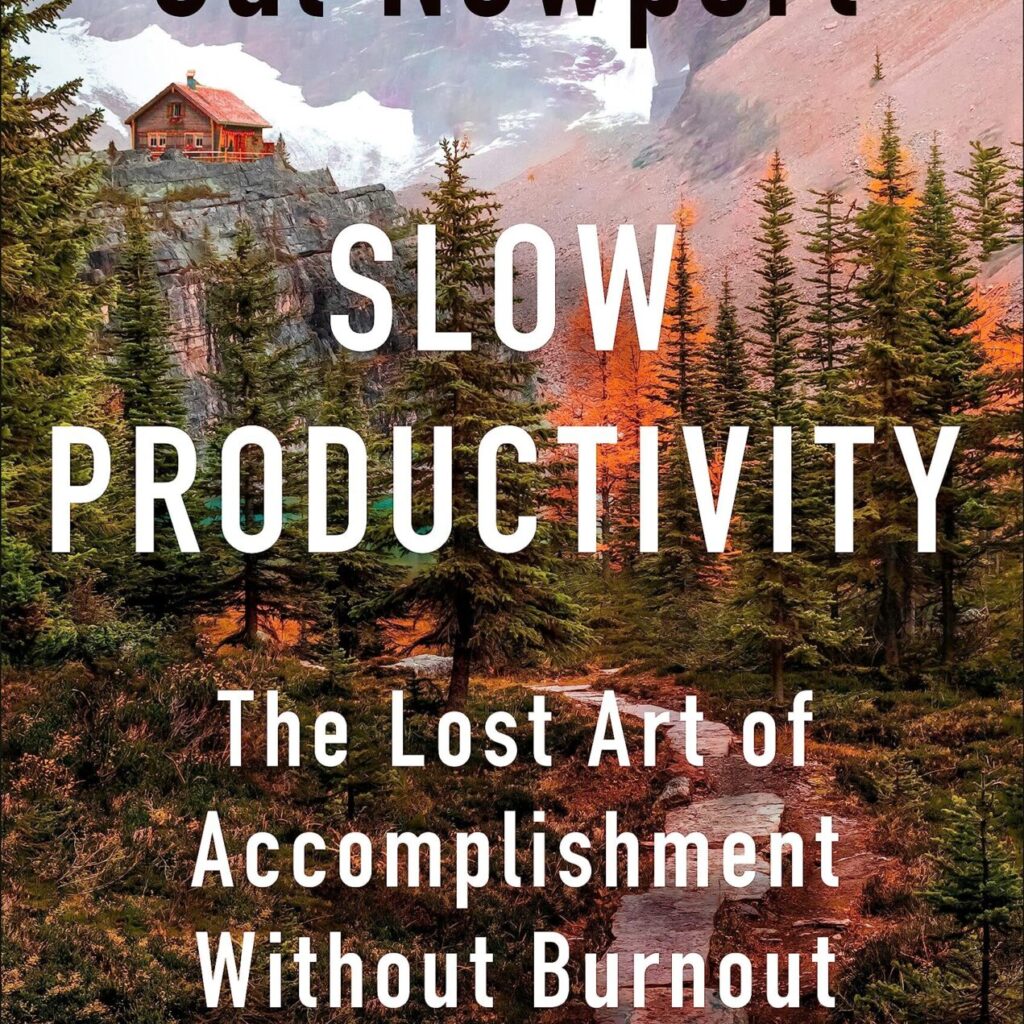
Embracing Slow Productivity: A Journey Through Cal Newport’s Transformative Philosophy
In a world that glorifies hustle and relentless busyness, the concept of productivity often becomes synonymous with overwork and burnout. Cal Newport’s Slow Productivity: The Lost Art of Accomplishment Without Burnout challenges this conventional wisdom, advocating for a more thoughtful and sustainable approach to work. By emphasizing quality over quantity and encouraging a slower, more deliberate pace, Newport offers a refreshing perspective on how to achieve meaningful results without sacrificing well-being. This blog post will explore the key themes, principles, and insights from Newport’s book, providing a roadmap for those seeking to navigate the complexities of modern work life.
Summary of Slow Productivity
Slow Productivity is structured around the premise that traditional measures of productivity—often rooted in industrial models—fail to capture the nuances of knowledge work. Newport argues that in our fast-paced, digitally driven world, many individuals fall into the trap of “pseudo-productivity,” where they appear busy but fail to produce meaningful results. The book is divided into three main principles that form the foundation of the slow productivity philosophy:
- Do Fewer Things: Prioritize and focus on the most impactful tasks.
- Work at a Natural Pace: Embrace a rhythm that aligns with human capabilities.
- Obsess Over Quality: Strive for excellence in every endeavor.
The Core Message
At its heart, Slow Productivity emphasizes that true productivity is not about doing more but doing what matters most. Newport encourages readers to step back from the frantic pace of modern work and reassess their commitments, allowing for deeper focus and higher quality output. By adopting a slow productivity mindset, individuals can achieve greater satisfaction and effectiveness in their professional lives.
Main Concepts and Insights
1. The Problem of Pseudo-Productivity
Newport begins by addressing the widespread issue of pseudo-productivity, where individuals equate busyness with effectiveness. He argues that this mindset leads to a cycle of stress and dissatisfaction, as people fill their schedules with tasks that do not contribute to meaningful outcomes.
Key Takeaway: Redefine Productivity
To combat pseudo-productivity, Newport suggests redefining what productivity means. Instead of measuring success by the number of tasks completed, individuals should focus on the quality and significance of their work.
2. Do Fewer Things
The first principle of slow productivity advocates for doing fewer things but doing them better. Newport emphasizes the importance of prioritizing tasks that align with long-term goals and values.
Key Takeaway: Simplify Your Commitments
By reducing obligations, individuals can create space for deeper engagement with the projects that truly matter. Newport encourages readers to evaluate their commitments and let go of those that do not serve their core objectives.
3. Work at a Natural Pace
Newport argues that working at a natural pace is essential for sustainable productivity. He highlights the importance of recognizing human limitations and avoiding the artificial intensity often imposed by modern work culture.
Key Takeaway: Embrace Varied Efforts
Instead of adhering to a relentless schedule, Newport encourages a more varied approach to work. This includes allowing for periods of intense focus interspersed with breaks and lighter tasks, creating a more humane work rhythm.
4. Obsess Over Quality
The final principle emphasizes the importance of quality in work. Newport argues that striving for excellence requires a slower, more deliberate approach, allowing individuals to produce work that is not only effective but also fulfilling.
Key Takeaway: Prioritize Excellence
By focusing on quality, individuals can differentiate themselves in a crowded marketplace. Newport encourages readers to invest time and effort into honing their craft, seeking feedback, and continuously improving their work.
Notable Examples and Case Studies
Throughout Slow Productivity, Newport provides various examples and anecdotes that illustrate his principles, making the concepts relatable and actionable.
The Slow Movement
Newport references the broader Slow Movement, which advocates for a more deliberate approach to various aspects of life, including food, travel, and work. This cultural shift serves as a backdrop for his arguments, reinforcing the idea that slowing down can lead to richer experiences and outcomes.
Successful Figures
Newport highlights successful individuals who embody the slow productivity philosophy, showcasing how they prioritize quality and focus over sheer busyness. These examples serve to inspire readers and demonstrate the effectiveness of a more intentional approach to work.
Key Themes Explored
The Misconception of Busyness
A central theme in Slow Productivity is the misconception that busyness equates to productivity. Newport challenges this notion, arguing that true productivity is about making meaningful contributions rather than simply appearing busy.
The Value of Reflection
Newport emphasizes the importance of reflection in the slow productivity process. By taking the time to assess progress and goals, individuals can make more informed decisions about where to focus their efforts.
The Role of Environment
The book explores how one’s environment can impact productivity. Newport suggests that creating a workspace conducive to focus and creativity can enhance the slow productivity experience.
The Importance of Mindfulness
Mindfulness plays a significant role in Newport’s philosophy. By being present and engaged in the moment, individuals can improve their focus and the quality of their work.
Practical Applications of Slow Productivity
Newport’s insights offer valuable lessons for anyone looking to enhance their productivity and well-being. Here are some key takeaways:
1. Assess Your Commitments
Take time to evaluate your current obligations and let go of those that do not align with your goals. Focus on a smaller number of meaningful tasks.
2. Embrace a Natural Work Rhythm
Allow yourself to work at a pace that feels comfortable and sustainable. Incorporate breaks and varied efforts into your routine to maintain balance.
3. Prioritize Quality Over Quantity
Strive for excellence in your work by dedicating time and effort to honing your skills. Seek feedback and continuously improve your craft.
4. Create a Supportive Environment
Design your workspace to promote focus and creativity. Minimize distractions and cultivate an atmosphere conducive to deep work.
5. Practice Mindfulness
Incorporate mindfulness practices into your daily routine. Take moments to reflect and engage fully in your tasks, enhancing your overall productivity.
Conclusion: A New Paradigm for Productivity
Slow Productivity serves as a transformative guide for navigating the complexities of modern work life. Cal Newport’s insights challenge the prevailing culture of busyness, advocating for a more thoughtful and intentional approach to productivity. By embracing the principles of slow productivity, individuals can achieve meaningful results while maintaining their well-being.
In a world that often prioritizes speed and quantity, Newport’s message is both timely and essential. He invites us to rethink our relationship with work, recognizing that true productivity is not about doing more but about doing what matters most. As we strive to implement these principles in our own lives, let us remember that the journey toward meaningful accomplishment is not a sprint but a marathon—one that requires patience, reflection, and a commitment to quality.
Ultimately, Slow Productivity is not just a guide to enhancing productivity; it is a call to embrace a more fulfilling and balanced approach to work and life. By adopting Newport’s philosophy, we can unlock our potential and create a sustainable path to success that enriches both our professional and personal lives.
Read Full Novel
Slow Productivity: The Lost Art of Accomplishment Without Burnout by Cal Newport
Read Related Novels
- Read The Creative Act by Rick Rubin eBook Review
- Read Invisible Women by Caroline Criado Pérez Summary
- Read Talking to Strangers by Malcolm Gladwell eBook Review
- Read Think Again by Adam M. Grant eBook Review
- “The Ride of a Lifetime” by Robert Iger, Joel Lovell eBook Review
- House of Flame and Shadow by Sarah J. Maa
- A Queen This Fierce and Deadly eBook Summary

